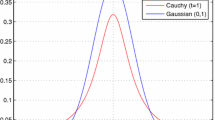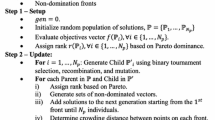Abstract
The aim of this article is to study the two-objective coverage problem of wireless sensor networks (WSNs) by means of differential evolution algorithm. Firstly, in order to reduce the computing redundancy of multi-objective optimization, namely to reduce the number of individuals which participate in non-dominated solution sorting, we introduced a fast two-objective differential evolution algorithm (FTODE). The FTODE contains a fast non-dominated solution sorted and a uniform crowding distance calculation method. The fast sorting method just handles the highest rank individuals but not all individuals in the current population. Meanwhile, during the individuals sorted, it can choose some of individuals into next generation and reduce the time complexity. The uniform crowding distance calculation can enhance the diversity of population due to it will retain the outline of optimal solution set by choosing the individual uniformly. Secondly, we use the FTODE framework to research the two-objective coverage problem of WSNs. The two objectives are formulated as: the minimum number of sensor used and the maximum coverage rate. For this specific problem, decimal integer encoding are used and a recombination operation is introduced into FTODE, which performs after initialization and guarantees at least one critical target’s sensor is divided into different disjoint sets. Finally, the simulation experiment shows that the FTODE provides competitive results in terms of time complexity and performance, and it also obtains better solutions than comparison algorithms on the two-objective coverage problem of WSNs.






















Similar content being viewed by others
References
Rault T, Bouabdallah A, Challal Y (2014) Energy efficiency in wireless sensor networks: a top-down survey. Comput netw 67(4):104–122
Fei Z, Li B, Yang S, Chen H, Hanzo L (2017) A survey of multi-objective optimization in wireless sensor networks: metrics, algorithms, and open problems. IEEE Commun Surv Tutor 19(1):550–586. https://doi.org/10.1109/COMST.2016.2610578
Xu YL, Wang XH, Zhang H (2016) Improved differential evolution to solve the two-objective coverage problem of wireless sensor networks. In: 2016 Chinese control and decision conference (CCDC), pp 2379–2384. https://doi.org/10.1109/CCDC.2016.7531383
Muhammad I, Muhammad N, Alagan A, Ashfaq A (2015) Wireless sensor network optimization: multi-objective paradigm. Sensors 15:17572–17620. https://doi.org/10.3390/s150717572
Chen Z, Li S, Yue W (2014) Memetic algorithm-based multi-objective coverage optimization for wireless sensor networks. Sensors 14:20500–20518
Parasuraman R, Fabry T, Molinari L (2014) A multi-sensor RSS spatial sensing-based robust stochastic optimization algorithm for enhanced wireless tethering. Sensors 14:23970–24003
Attea BA, Khalil EA, Ozdemir S, Yildiz O (2015) A multi-objective disjoint set covers for reliable lifetime maximization of wireless sensor networks. Wirel Pers Commun 81(2):819–838
Rebai M, Le BM, Snoussi H, Hnaien F, Khoukhi L (2015) Sensor deployment optimization methods to achieve both coverage and connectivity in wireless sensor networks. Comput Oper Res 59:11–21
Yoon Y, Kim YH (2013) An efficient genetic algorithm for maximum coverage deployment in wireless sensor networks. IEEE Trans Cybern 43(5):1473–1483. https://doi.org/10.1109/TCYB.2013.2250955
Deb K, Pratap A, Agarwal S, Meyarivan T (2002) A fast and elitist multiobjective genetic algorithm: NSGA-II. IEEE Trans Evol Comput 6(2):182–197. https://doi.org/10.1109/4235.996017
Zitzler E, Laumanns M, Thiele L (2001) SPEA2: Improving the strength pareto evolutionary algorithm for multiobjective optimization. In: Proceeding of evolutionary methods design, optimization and control application to industrial problems, p 95–100.
Li H, Zhang Q (2009) Multi-objective optimization problems with complicated pareto sets, MOEA/D and NSGA-II. IEEE Trans Evol Comput 13(2):284–302. https://doi.org/10.1109/TEVC.2008.925798
Zhang Q, Li H (2007) MOEA/D: a multi-objective evolutionary algorithm based on decomposition. IEEE Trans Evol Comput 11(6):712–731
Cheng R, Jin Y (2015) A multi-objective evolutionary algorithm using Gaussian process based inverse modeling. IEEE Trans Evol Comput 19(6):838–856
Deb K, Jain H (2014) An evolutionary many-objective optimization algorithm using reference-point-based nodominated sorting approach, part 1: solving problems with box constraints. IEEE Trans Evol Comput 18(4):577–601
Zhang X, Tian Y, Jin Y (2015) A knee point driven evolutionary algorithm for many-objective optimization. IEEE Trans Evol Comput 19(6):761–776
Zeng GQ, Chen J, Li LM (2016) An improved multi-objective population-based extremal optimization algorithm with polynomial mutation. Inf Sci 330:49–73
Chen MR, Lu YZ (2008) A novel elitist multiobjective optimization algorithm: multiobjective extremal optimization. Eur J Oper Res 188:637–651
Zeng GQ, Chen J, Dai YX et al (2015) Design of fractional order PID controller for automatic regulator voltage system based on multi-objective extremal optimization. Neurocomputing 160:173–184
Li LM, Lu KD, Zeng GQ, Chen MR (2016) A novel real-coded population-based extremal optimization algorithm with polynomial mutation: a non-parametric statistical study on continuous optimization problems. Neurocomputing 174:577–587
Storn R, Price K (1997) Differential evolution: a simple and efficient heuristic for global optimization over continuous spaces. J Glob Optim 11(4):341–359
Xue F (2005) Modeling and convergence analysis of a continuous multi-objective algorithm. In: Proceedings of IEEE international conference on evolutionary computation, p 228–235
Robic T (2005) DEMO: differential evolution for multi-objective optimization. In: Proceedings of IEEE 3rd international conference on evolutionary multi-criterion computation, p 520–533
Du W, Leung S, Tang Y, Vasilakos AV (2017) Differential evolution with event-triggered impulsive control. IEEE Trans Cybern 47(1):244–257. https://doi.org/10.1109/TCYB.2015.2512942
Bi XJ, Wang C (2017) An improved NSGA-III algorithm based on elimination operator for many-objective optimization. Memet Comput 9:361–383. https://doi.org/10.1007/s12293-017-0240-7
Meza J, Espitia H, Montenegro C, Crespo RG (2016) Statistical analysis of a multi-objective optimization algorithm based on a model of particles with vorticity behavior. Soft Comput 9:3521–3536. https://doi.org/10.1007/s00500-015-1972-2
Chong JK (2016) A novel multi-objective memetic algorithm based on opposition-based self-adaptive differential evolution. Memet Comput 8(2):147–165. https://doi.org/10.1007/s12293-015-0170-1
Xu YL, Fang JA, Zhu W (2013) Differential evolution for lifetime maximization of heterogeneous wireless sensor networks. Math Probl Eng 2(1):1. https://doi.org/10.1155/2013/172783
Tian Y, Cheng R, Zhang XY, Jin YC (2017) PlatEMO: a matlab platform for evolutionary multi-objective optimization educational forum. IEEE Compt Intell Mag 12(4):73–87. https://doi.org/10.1109/MCI.2017.2742868
Zhang X, Tian Y, Cheng R, Jin Y (2015) An efficient approach to non-dominated sorting for evolutionary multi-objective optimization. IEEE Trans Evol Comput 19(2):201–213. https://doi.org/10.1109/TEVC.2014.2308305
Acknowledgements
The authors gratefully acknowledge the helpful comments and suggestions of editors and anonymous reviewers. This work was supported by the key scientific research project of Henan provinces’ university (Nos. 15A520083 and 17B520017); the National Natural Science Foundation of China (Nos. 81703946, 61503328, 61772475 and 61502434); the doctoral research fund in Henan University of Chinese Medicine (Nos. BSJJ2015-19); the science and technology research Project of Henan province (Nos. 172102210361 and 172102310536).
Author information
Authors and Affiliations
Corresponding author
Ethics declarations
Conflict of interest
The authors declare that they have no conflict of interest.
Additional information
Publisher's Note
Springer Nature remains neutral with regard to jurisdictional claims in published maps and institutional affiliations.
Rights and permissions
About this article
Cite this article
Xu, Y., Ye, Y., Zhang, H. et al. A fast two-objective differential evolution for the two-objective coverage problem of WSNs. Memetic Comp. 11, 89–107 (2019). https://doi.org/10.1007/s12293-018-0264-7
Received:
Accepted:
Published:
Issue Date:
DOI: https://doi.org/10.1007/s12293-018-0264-7




